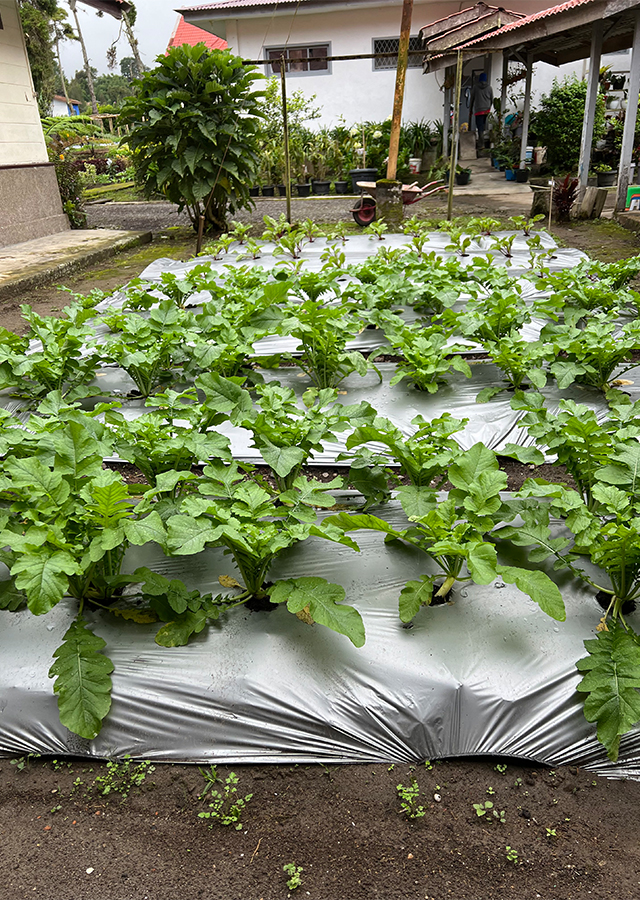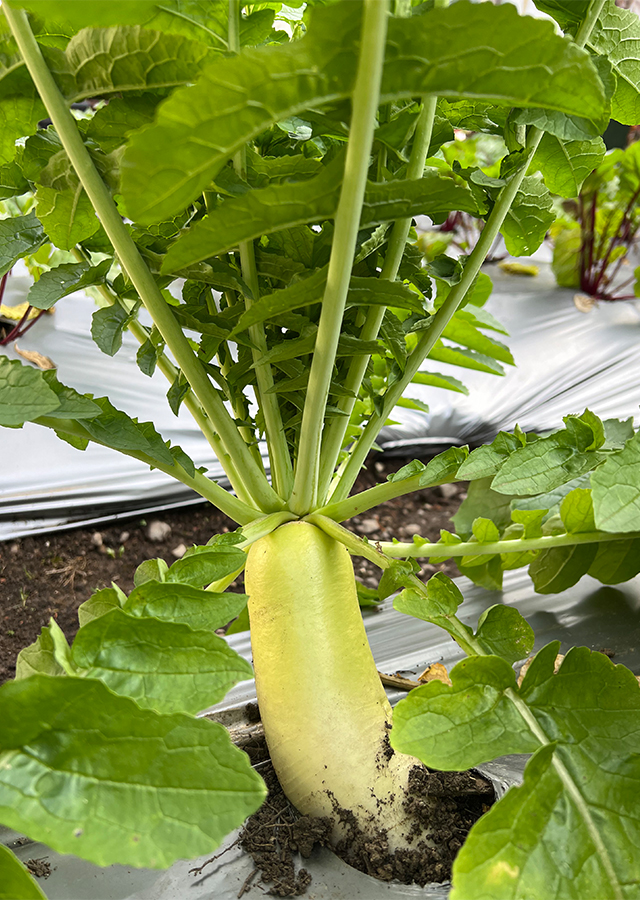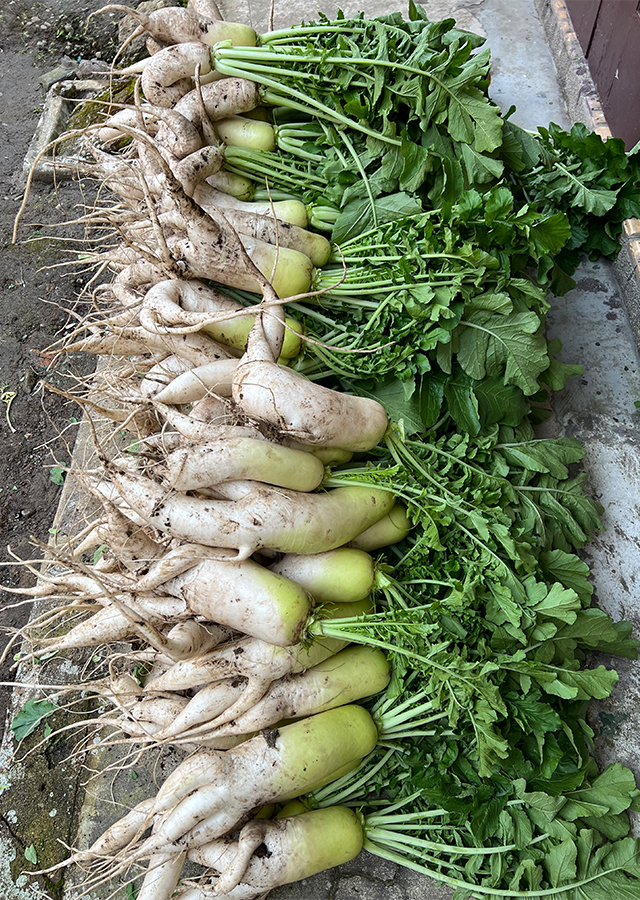Radish
Raphanus raphanistrum subsp. sativus (L.) Domin
Brassicaceae
Location in our garden
Vegetable



Synonym
Raphanus sativus L.
Raphanus caudatus L.
Raphanus radicula Pers.
Habitus
Herbaceous. Erect annual herb up to 1 m tall
Part Used
Leaves
Seeds
Roots
Growing Requirements
Full Sunshine
Drought Resistant
Low Temperature
Habitat
Terrestrial
Overview
The origin of radish is not known, the area of maximum diversity of radish lies between the eastern Mediterranean and the Caspian Sea, which is probably the original gene centre for this species. Radish was cultivated already in ancient times in the Mediterranean, from where it spread to China in about 500 BC and to Japan in about 700 AD. It has now spread throughout the world. Now, radish can be found as a cultigen throughout the world in many different forms. This species is grown mainly for its thickened fleshy root. In Southeast Asia, the tuberous root is typically used in soups, sauces or meat dishes. Its can also be eaten fresh, mixed with other vegetables such as tomato, and the leaves are can be eaten as salad or spinach. Leaf radish is mainly grown as green manure and forage in central and western Europe and is also grown as fodder for cattle in South Africa. In traditional medicine, radish also have many health benefits. In India, this plant (seed) is widely used as expectorant and laxative.
Vernacular Names
Radis (France), Radies, Rettig (Germany), Radice, Ramolaccio, Ravanello, Ravano (Italy), Daikon (Japan), Radijs, Ramenas (Netherlands), Labanos (Reddik), Rädisa, Raettika (Sweden), Cu-cai trang (Vietnam), Lobak, Lobak putih (Malay), Mulo (Nepalese), Rabanete (Portuguese), Hua phak kat khao, Hua chai táo (Thai).
Agroecology
Radish is a vegetable of temperate regions or a cool-season. Cool conditions stimulate vigorous growth. Short day length stimulates root development; high temperature stimulates the development of inflorescences. Performing best in the tropics at higher latitudes (>10°) during the cool season and in highlands above 1.000 m. Radish normally grow in a sunny location and regular watering. This species requires light, moist, well-drained, sandy, deep soils with a pH of 6.0–6.5. Heavy soils may bring about misshapen roots.
Morphology
- Roots - very widely in terms of shape and size. The upper part of the taproot and the hypocotyl (the portion of the stem below the cotyledons) becomes swollen and forms a white, cylindrical tuber, fleshy, globular. It has a mild flavour and a crisp texture.
- Leaves - stipules absent, either glabrous or have a few stiff hairs. The lower leaves are larger than the upper ones and arranged in a rosette instead of alternate leaf arrangement. Lower leaves are oblong (elongated), oblong-ovate (elongated to egg-shaped) to lyrate-pinnatifid (leaf blade divided into lobes that create a feather-like pattern with the largest lobe at the tip), higher leaves much smaller, shortly petioled.
- Flowers - bisexual, 4-merous, white to light purple. Sepals free, oblong-linear. Petals free and spatulate. Stamens 6, 4 long and 2 short. Fragrant flowers (1.5 cm wide) are arranged in a raceme (a spike-like inflorescence composed of flowers mounted on stalks up to 2.5 cm long). The raceme occurs near the stem tip.
- Fruit - cylindrical, consisting of 2- several superposed joints, lower joint very short and seedless, upper one much larger, terete, spongy and divided into 2-12 one-seeded compartments, indehiscent, with a long, seedless beak.
- Seed - ovoid-globose, about 3 mm in diameter, yellowish.
Cultivation
Propagated by seed. Seeds may take 4 to 10 days to germinate at 20 - 30 °C. Depending on the varieties, the plant may take 21 to 60 days to mature.
Chemical Constituents
Alkaloids (pyrrolidine, phenethylamine, N-methylphenethylamine, 1,2- pyrrolidin-tion-3-il-3-acid-caroxilic-1,2,3,4-tetrahydro-ß-carbolin, and sinapin), flavonoid (kaempferol, kaempferol 3-O-α-arabinopyranoside, kaempferol 3-O-α- rhamnopyranoside, kaempferol 3-O-β-glucopyranoside-7-O-α-rhamnopyranoside, kaempferol 3-O-α-rhamnopyranoside-7-O-β-glucopyranoside, kaempferol 3,7-di-O-α-rhamnopyranoside, kaempferol 3-O-(2′′−β-glucopyranosyl)-α-rhamnopyranoside-7-O-α-rhamnopyranoside, quercetin 3-O-α- rhamnopyranoside-7-O-α-arabinopyranoside, quercetin 3-O-β-glucopyranoside-7-O-α-rhamnopyranoside, quercetin 3-O-α-rhamnopyranoside-7-O-β-glucopyranoside), glycosides, cardiac glycosides, tannins , saponins, amino acids, terpenoids, steroids, coumarins, phenolic compounds, raphanol, rettichol, essential oils, methylmercaptan, sulfuric acid, erucic acid, the four main organic acids (oxalic, malic, malonic, and erythorbic acids), ascorbic acid.
Traditional Medicinal Uses
- Juice of leaves increases the flow of urine and promotes bowel movements, also used as laxative, for dropsy and general anasarca.
- For diarrhea: boil the fresh leaves to concentrated decoction and drink.
- Root considered stimulant; also used for piles and stomach pains. Juice used to expel wind from the bowels.
- Juice of fresh roots considered antiscorbutic.
- Roots are crushed and applied locally as dressing or poultice for burns, scalds, ecchymoses, or fetid or smelly feet.
- Decoction of root used for fevers, and bring out the rash in eruptive fevers.
- Seeds promote the flow of urine, bowel movements, menstruation and used for cancer of the stomach.
- Seeds, leaves, and old roots used in treatment of asthma and other chest complaints.
- For patients with edema, bloated belly (ascites), pale yellowish face, and oliguria: used dried root preparation with citrus rind preparation (5:1 proportion). Boil to a concentrated decoction and drink.
- In India, plant used as purgative, stimulant, antiscorbutic, diuretic and lithotryptic. Roots used for piles, gastric pains, dysuria and strangury. Seeds used as expectorant, diuretic, laxative, and carminative.
- In Iranian traditional medicine used as laxative, antitumor, antiproliferative, and abortifacient.
- In Sulaymaniya Province, Kurdistan, Iraq, used to cure kidney stones and gallstones, for increasing breast milk, and as diuretic.
Part Used
Reference Sources
- Royal Botanic Gardens. 2021. Plants of the World Online: Raphanus raphanistrum subsp. sativus. https://powo.science.kew.org/taxon/urn:lsid:ipni.org:names:77159305-1. 20-21-2021.
- Flora Fauna Web. 2021. Raphanus raphanistrum subsp. sativus cultivar [White Oriental Radish]. https://www.nparks.gov.sg/florafaunaweb/flora/3/3/3336. 20-12-2021.
- PROTA4U. Raphanus sativus L. https://www.prota4u.org/database/protav8.asp?h=M6&t=radish%E2%80%99&p=Raphanus+sativus. 20-12-2021.
- CAB International. 2021. Invasive Species Compendium. Raphanus sativus (radish). https://www.cabi.org/isc/datasheet/46796#toPictures. 20-12-2021.
- Stuartxchange. 2019. Labanos. http://www.stuartxchange.com/Labanos.html. 20-12-2021.


